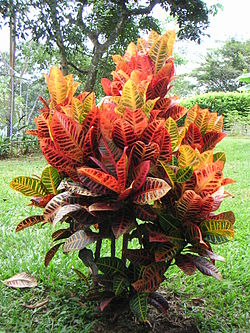| Codiaeae | |
|---|---|
 | |
| Codiaeum variegatum | |
| Scientific classification | |
| Kingdom: | Plantae |
| Clade: | Tracheophytes |
| Clade: | Angiosperms |
| Clade: | Eudicots |
| Clade: | Rosids |
| Order: | Malpighiales |
| Family: | Euphorbiaceae |
| Subfamily: | Crotonoideae |
| Tribe: | Codiaeae Hutch. |
| Genera | |
Codiaeae is a tribe of the subfamily Crotonoideae, under the family Euphorbiaceae. [1] [2] It comprises 15 genera.